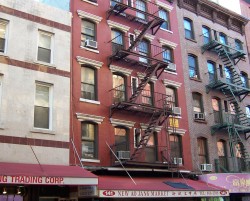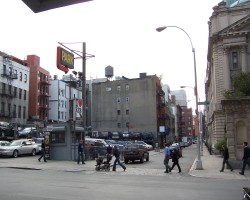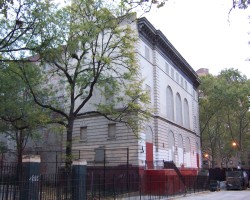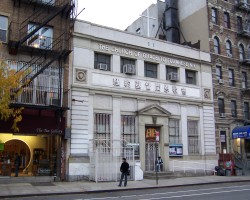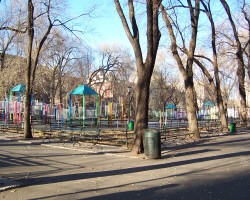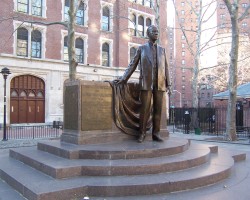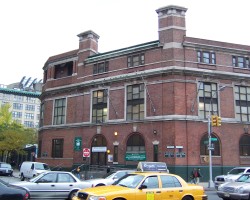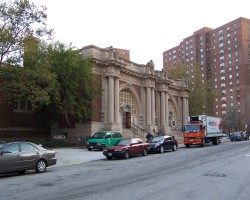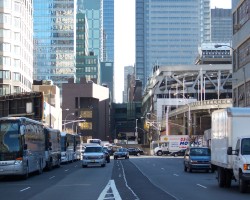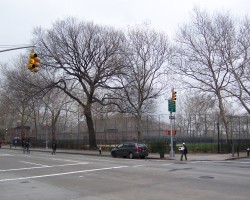Public Baths
At the turn of the 20th century, New York was a densely populated industrial city with many of the city's residents living in squalid tenement homes that lacked facilities for regular bathing. In keeping with the strong progressive spirit of that era, the city built "public baths" that were buildings of showers intended to promote personal cleanliness and, ultimately, Godliness and good civic behavior. As private bathrooms became more universal, the bathhouses became unnecessary and most were decommissioned soon after the end of World War II, although at least one bath held out until the city's financial crisis closed it in the 1970s.
Many of the buildings were substantial works of architecture and, surprisingly, have survived to the time of this writing (Fall 2006). Some were located in public parks and since they often included other recreational facilities, they naturally became recreational centers. Others were cleared to make way for large public housing projects or, in a few cases, stood quietly as high-rise housing was built around them. This page contains photos of the remaining bathhouse buildings.
New York City's Public Baths should not be confused with the variety of recreational baths (e.g. Turkish Baths) that have also been a part of New York life for decades. They are also usually distinct from the "bath houses" where gay men had been meeting which since the late 19th century to engage in clandestine and/or anonymous sexual activity. Indeed, the widespread opening of exclusively gay bath houses did not occur until after World War II, when most of New York's public baths began closing.
History
Notable examples of public bathing from antiquity include the lavish baths of the Romans and the ritual bathing of the Egyptians and Hebrews. With the fall of the Roman Empire, public bathing also fell out of favor in the West until after the 13th century when public baths became commonplace in European cities, possibly from the influence of contacts with Byzantine and Muslim societies during the Crusades. Public bathing was suppressed by changes in morality during the 17th century Reformation but made a comeback with the early 19th century industrial revolution and increased urban density. The use of showers for mass bathing became common in the middle 19th century beginning with barracks installations by the French and German military.
In a time before plentiful, heated running water, European Americans followed the continental custom of rarely washing the entire body. With the advent in the mid-19th century of municipal water and sewage systems, bathing for the middle and upper class became more commonplace with both commercial bathhouses and private bathing facilities in homes. This trend was also encouraged by an increasing understanding of the importance of cleanliness to health and urban reformers as early as the 1840s were advocating for the provision of public bathing facilities for the poor.
In 1849 the New York state legislature authorized the New York Association for Improving the Condition of the Poor (AICP) to incorporate the People's Bathing and Washing Association and build a public bath. The People's Bathing and Washing Establishment opened at 141 Mott Street in 1852. Although serving around 60,000 patrons a year, the bath never became financially self-sufficient and closed with the beginning of the Civil War in 1861.
Following the war, New York City followed Boston's example by building comparatively inexpensive floating public bathing facilities in surrounding rivers that could be used in the Summer months. These floating baths had dressing rooms and were basically floating wooden swimming pools that were docked by the river edge and filled with river water. The first two floating baths were opened in 1870 and by 1888 the city was operating fifteen free baths, serving an average of 2.5 million men and 1.5 million women a year. While advocates and civic authorities viewed their purpose as hygienic, patrons, especially young boys, saw them as recreational facilities, necessitating imposition of 25-minute time restrictions. These facilities continued to exist well into the 20th century, although river pollution required the installation of filtration machinery.
Because of their seasonality, the floating baths were not an adequate solution for New York's expanding and disease-ridden slums. A wider understanding of germ theory added a scientific patina to idealistic progressive beliefs that promotion of personal cleanliness would result in increased self-respect, a desire for self-improvement and, subsequently, improved material and moral conditions. Bathing was also seen as a habit that would promote the Americanization of the burgeoning immigrant population as they threw off their unsanitary old-world habits. This idealism ran into conflict with an equally irrational Gilded Age aversion to government intervention against the natural order, which has eerie parallels to contemporary political conservatism. But as an increasing percentage of New York's citizens were living in densely populated buildings with no bathing facilities, the need for a solution became inescapable. One solution was the construction of a mass transportation system that would reduce urban density by permitting workers to live beyond walking distance of their jobs.
Another solution was the construction of public baths.
On April 21, 1895, New York State legislature passed a law (Chapter 351) requiring all first- and second-class cities in the state (at that time, New York City, Brooklyn, Buffalo, Rochester, Syracuse, Troy, and Utica) to build public bathing facilities. However, complex political, financing and siting issues delayed opening of the first bath (Rivington Street) until 1901.
Although the 20 municipal baths did achieve significant levels of patronage, especially on hot Summer days, the 7.5 million baths offered at the height of of the operations in 1920 was significantly below the theoretical annual capacity of 20 million. The Tenement House Law of 1901 (passed the same year as the opening of the first bath) required new apartments to provide toilet facilities and most landlords chose to include baths as well. The bathhouse movement had accomplished its goals by 1915 and quietly ceased its activism. The bathhouses were renovated by the WPA in the 1930s and continued to operate through World War II. However, after the war most of the bathhouses were converted to other uses or demolished to make way for other structures or expanded parkland. The final survivor, the Allen Street Bath, finally closed during the city's financial crisis of the 1970s.
The quintessential reference on public baths in the United States is Marilyn Thornton Williams' book, Washing "The Great Unwashed" - Public Baths in Urban America, 1840 - 1920.. While this book is long out of print, Ohio State Press has a PDF version that can be downloaded or read online.. This book includes a fascinating look into the complex political machinations behind the scenes of the public bath movement and is highly recommended. The New York City Parks Department website also contains some information on specific bathhouse buildings, primarily on historic markers.
